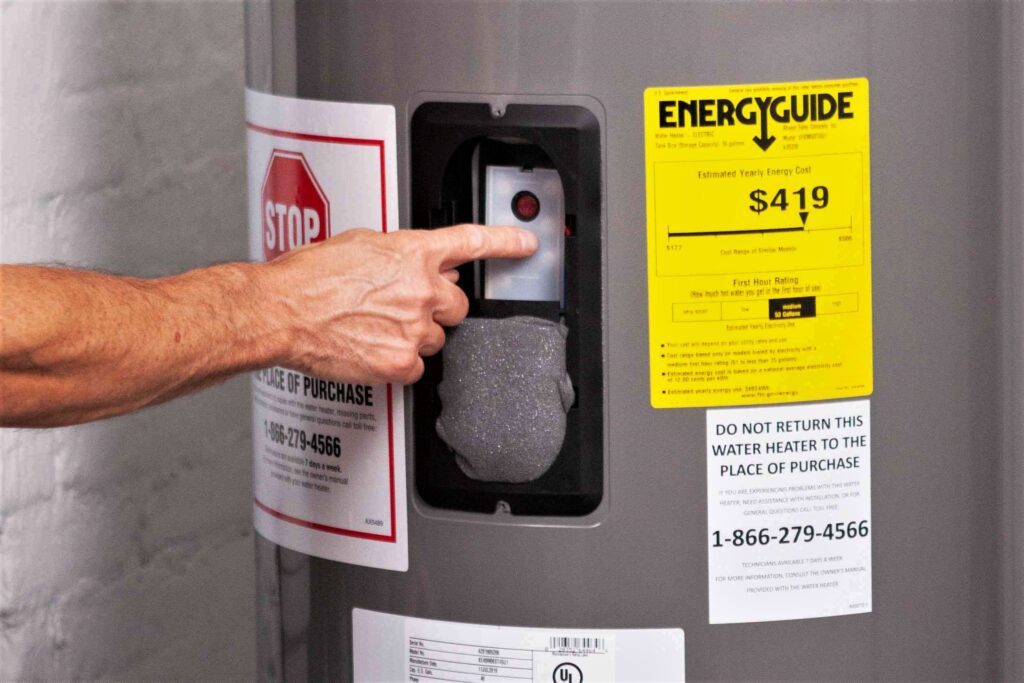Electric water heaters resemble their gas-powered cousins in appearance. Both employ a steel storage tank jacket with insulation between the tank jacket and the storage tank to lessen the heat loss of the heated water. The heat source is the primary distinction between gas and electric water heaters. Gas burners are used in gas water heaters to heat the water from below the tank.
Failure of the heating element, which results in little or no heat generation, is one of the most frequent issues with electric water heaters. Fortunately, it’s a cheap component requiring little DIY water heater repair knowledge. Other recurring issues include incorrect settings, high water pressure in the house, and a lack of tank maintenance, which could make your water heater quit working.
Here are seven typical issues and possible electric water heater repair solutions that you might want to attempt yourself.
Before You Begin: Check the Warranty
Look up the warranty on the water heater before you begin troubleshooting it. Water heaters are sold with a limited warranty for home and commercial use. A rating plate with the model and serial number is located on each tank. If the tank has a prorated warranty that could provide a replacement tank or parts, free of charge or at a discount, it will be determined by these numbers, which give the year the tank was manufactured.
If there are any indications that your water heater is malfunctioning, such as a low level of hot water in your home, take a picture or note the information and contact the manufacturer. But take note that field labor is often not covered by manufacturer warranties.
WARNING
Working with high-voltage (240-volt) electric water heaters is dangerous when the electricity is on. Turn off the power to the heater’s circuit by turning off the relevant breaker in your home’s service panel before inspecting any electrical components of a water heater (breaker box). Before touching any wires inside the water heater, ensure the power is off by testing all of the wires with a non-contact voltage tester.
No Hot Water
It’s possible that a water heater isn’t receiving electricity, a limit switch has tripped, or one or more heating components have failed.
How to Fix
First, ensure the circuit breaker for the water heater in the service panel hasn’t tripped.
Reset the heater’s high-temperature limit if the breaker did not trip or if it is still on.
1. In the service panel, shut off the breaker for the circuit that controls the water heater.
2. Take off the water heater’s access panel for the top heating element.
3. Take off the plastic safety shield and insulation, not touching any wires or electrical contacts.
4. Press the red button above the higher thermostat, which resets the high-temperature cutoff.
5. Change the access panel, insulation, and safety guard.
6. Open the circuit breaker for the heater.
7. Test each heating element and replace it if necessary if it doesn’t fix the issue.
Inadequate Hot Water
Your unit can be too small to supply the home’s hot water needs if your water heater produces hot water but not enough. Make sure the demand is within the water heater’s capability.
How to Fix
Hot water should make up 75% of the water heater’s capacity. For instance, a 40-gallon water heater is adequate for a 30-gallon need. Try to shorten showers, install low-flow showerheads, and spread out dishwashing and laundry to different times of the day rather than doing them all at once if demand exceeds the heater’s capacity.
One or both of your unit’s heating elements may have failed and need to be replaced if it is not undersized or if it suddenly produces less hot water than previously. When the hot water in the battery runs out quickly, the lower heating element is broken.
Water Leaks
Water Leaks leaks can also be related to tank issues. However, they are typically brought on by failing valves and plumbing connections. Water leaks can seriously harm a house, so it’s crucial to stop them immediately.
How to Fix
Corroded tanks or slack heating elements may cause water heater tank leaks. Check the details for slackness and, if necessary, use an element wrench to tighten them.
A rusted tank needs to be replaced because it cannot be fixed. To halt the leaking, turn off the water heater’s electricity and water supply. Next, drain the tank.
Rust-Colored Water
Rust-Colored Water or Bad Odor If the water coming from your faucet is brown, yellow, or red, corrosion may occur inside your water heater tank or in your home’s pipes. In a similar vein, bacteria in the water heater tank may be the cause of water that smells like rotten eggs.
How to Fix
The anode rod in the tank may need to be replaced, which usually calls for the assistance of a qualified plumber.
Tank Making Noises
Is your water heater making any noises? Is there a low rumbling or popping sound? Alternatively, might it be a loud whine? The sound you’re hearing may be the sound of boiling water. The bottom of the tank may overheat if there is an excessive buildup of sediment, which will result in the water boiling.
How to Fix
Draining the tank to remove the silt is the first thing to attempt. You might need to have the tank replaced if that doesn’t work.
